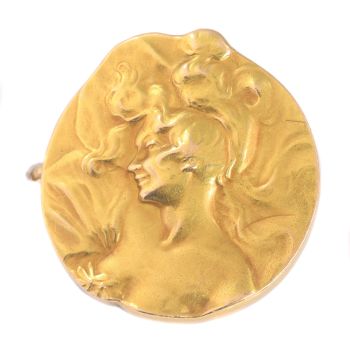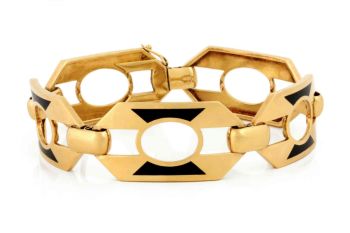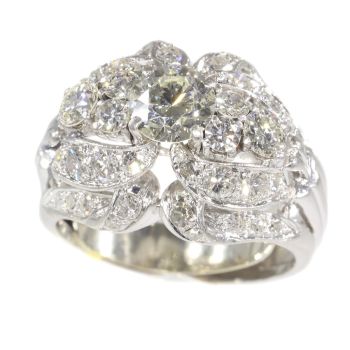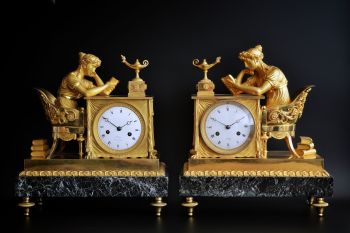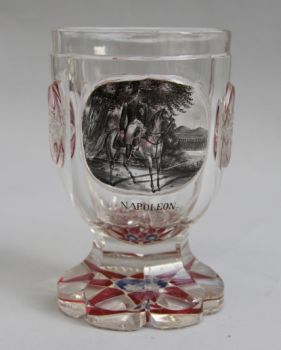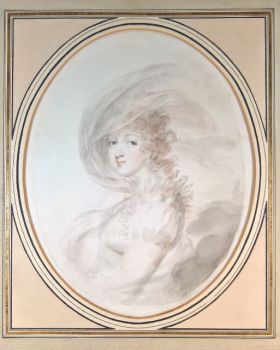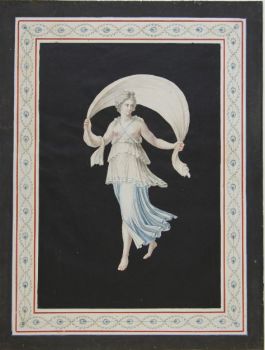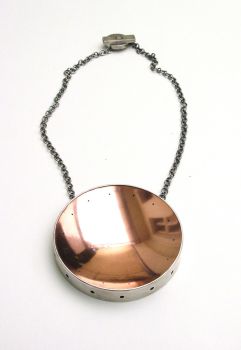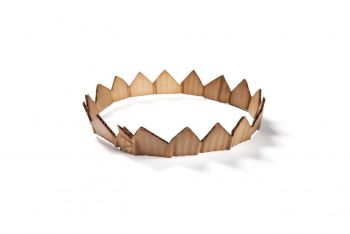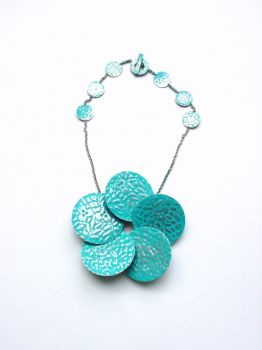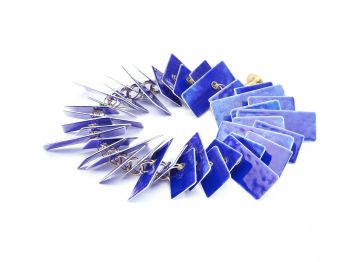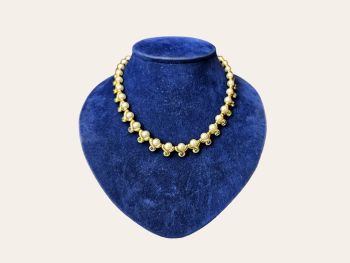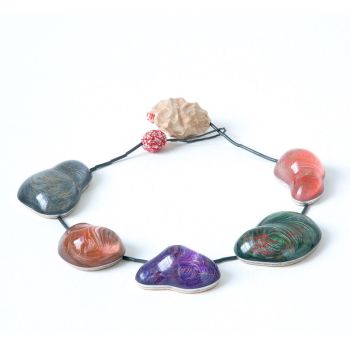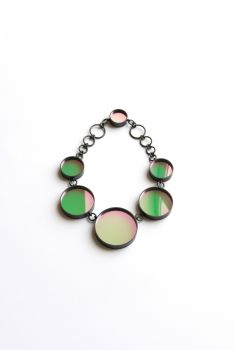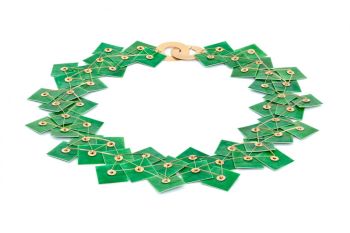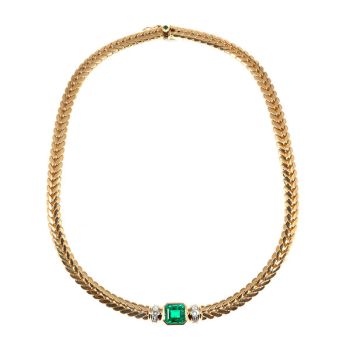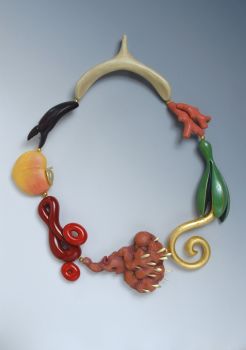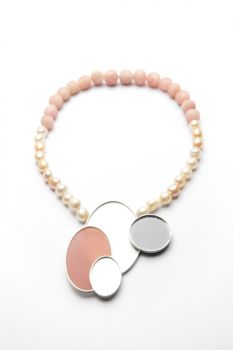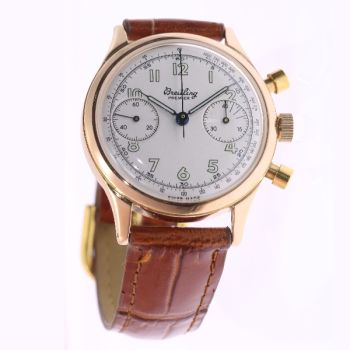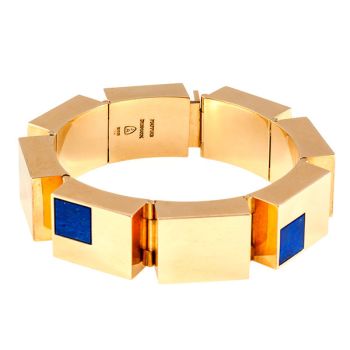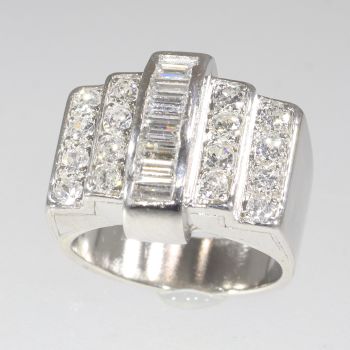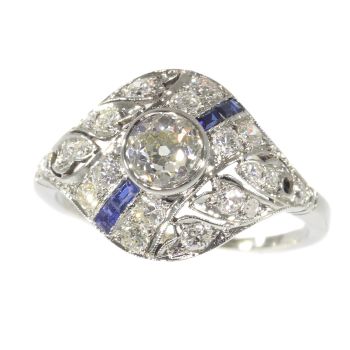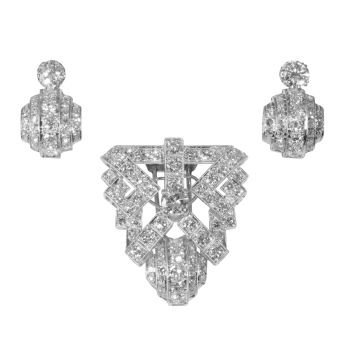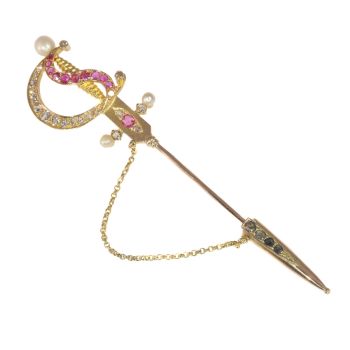Französische antike Goldkette mit Emaille sogenannter Collier d'esclave 1810
Unbekannter Künstler
Adin Fine Antique Jewellery
- Über Kunstwerk
Antique jewelry object group: necklace
Condition: excellent condition
- (more info on our condition scale)
Country of origin:France
Style: Empire - The Empire style, sometimes considered the second phase of Neoclassicism, is an early-19th-century design movement in architecture, furniture, other decorative arts, and the visual arts followed in Europe and America up to around 1830. Thestyle originated in and takes its name from the period when Napoleon I ruled France, known as the First French Empire, where it was intended to idealize Napoleon's leadership and the French state. The style corresponds to the Biedermeier style in theGerman-speaking lands, Federal style in the United States and to the Regency style in Britain. An earlier phase of the style was called the Adam style in Great Britain and "Louis Seize" or Louis XVI, in France.
- See also: Empireor more info on styles
Period: ca. 1810
- (events & facts of this era, poetry of this era, fashion of this era)
Material: 18K bi-color (yellow and red) gold
- (more info on precious metals)
Technique: Enamelling is an old and widely-adopted technology. The ancient Egyptians applied enamels to pottery and stone objects. The ancient Greeks, Celts, Russians, and Chinese also used enameling processes on metal objects. Enamel is the colorful result offusing powdered glass to a substrate by firing, usually between 750 and 850 degrees Celsius. The powder melts and flows and hardens to a smooth, durable vitreous coating on metal, glass or ceramic. According to some sources, the word enamel comes fromthe High German word smelzan (to smelt) via the Old French esmail. Used as a noun, "an enamel" is a usually small decorative object, coated with enamel coating, such as a champlevé or a cloisonné (different techniques).
The type of enameling is typical for the city Bresse in France, hence the name Bresse Enamel.
Extra information: Collier d'esclavage- Esclavage is French and literally it means slavery. We'll leave it to your imagination to give an interpretation to this naming. It is a type of necklace composed of three or more chains or strings of beads or jewels in which thechains or strings hang approximately equidistant from each other. They were worn in Normandy as peasant jewelry in the mid-18th century. Such jewels were in many regions of France the most beautiful jewel offered by the bridegroomto his bride the day of their wedding. The definition of 'collier esclavage' appears for the first time in the 'Dictionnaire de Trévoux' in 1752. This necklace knows a very large geographical diffusion. In Normandy thegold pieces were often engraved. A collier d'esclave is an extremely rare article to find and we are proud to be able to offer one here.
Hallmarks: The French hallmark depicting a rooster's head which was used in France for 18K gold around 1810.
- (more info on hallmarks)
Dimensions: length 51,00 cm (20,08 inch) cm
Weight: 13,90 gram (8,94 dwt)
Reference Nº: 15128-0176
Copyright photography: Adin, fine antique jewelry
- Über Künstler
Es kann vorkommen, dass ein Künstler oder Hersteller unbekannt ist.
Bei einigen Werken ist nicht zu bestimmen, von wem sie hergestellt wurden, oder sie wurden von (einer Gruppe von) Handwerkern hergestellt. Beispiele sind Statuen aus der Antike, Möbel, Spiegel oder Signaturen, die nicht klar oder lesbar sind, aber auch einige Werke sind überhaupt nicht signiert.
Außerdem finden Sie folgende Beschreibung:
•"Zugeschrieben …." Ihrer Meinung nach wohl zumindest teilweise ein Werk des Künstlers
•„Atelier von ….“ oder „Werkstatt von“ Ihrer Meinung nach eine Arbeit, die im Atelier oder in der Werkstatt des Künstlers, möglicherweise unter seiner Aufsicht, ausgeführt wurde
•„Kreis von ….“ Ihrer Meinung nach ein Werk aus der Zeit des Künstlers, das seinen Einfluss zeigt, eng mit dem Künstler verbunden, aber nicht unbedingt sein Schüler
•"Art von …." oder „Anhänger von ….“ Ihrer Meinung nach eine Arbeit, die im Stil des Künstlers ausgeführt wurde, aber nicht unbedingt von einem Schüler; kann zeitgenössisch oder fast zeitgenössisch sein
•„Art von ….“ Ihrer Meinung nach ein Werk im Stil des Künstlers, aber späteren Datums
•"Nach …." Ihrer Meinung nach eine Kopie (jegliches Datums) eines Werks des Künstlers
• „Unterzeichnet …“, „Datiert …“. oder „Beschriftet“ Ihrer Meinung nach wurde das Werk vom Künstler signiert/datiert/beschriftet. Das Hinzufügen eines Fragezeichens weist auf einen Zweifel hin
• „Mit Unterschrift …“, „Mit Datum …“, „Mit Aufschrift ….“ oder „Trägt Unterschrift/Datum/Beschriftung“ ihrer Meinung nach die Unterschrift/Datum/Beschriftung von jemand anderem als dem Künstler hinzugefügt wurde
Sind Sie daran interessiert, dieses Kunstwerk zu kaufen?
Artwork details
Related artworks
- 1 - 4 / 12
Unbekannter Künstler
Set Franse Empire Pendules / Empire Lectura penduleearly 19th
Preis auf AnfrageKuipers Kunst & Antiek
Unbekannter Künstler
Set of eight gouache drawings1799 - 1801
Preis auf AnfrageRobert Schreuder Antiquair
Unbekannter Künstler
Diamantarmband aus dem 18. Jahrhundert mit 2000 Jahre alten Intaglios1790
€ 23.000Adin Fine Antique Jewellery
 Kuratiert von
Kuratiert vonDanny Bree
1 - 4 / 15- 1 - 4 / 24
- 1 - 4 / 24
Unbekannter Künstler
Diamantarmband aus dem 18. Jahrhundert mit 2000 Jahre alten Intaglios1790
€ 23.000Adin Fine Antique Jewellery
 Kuratiert von
Kuratiert vonDanny Bree
1 - 4 / 12













